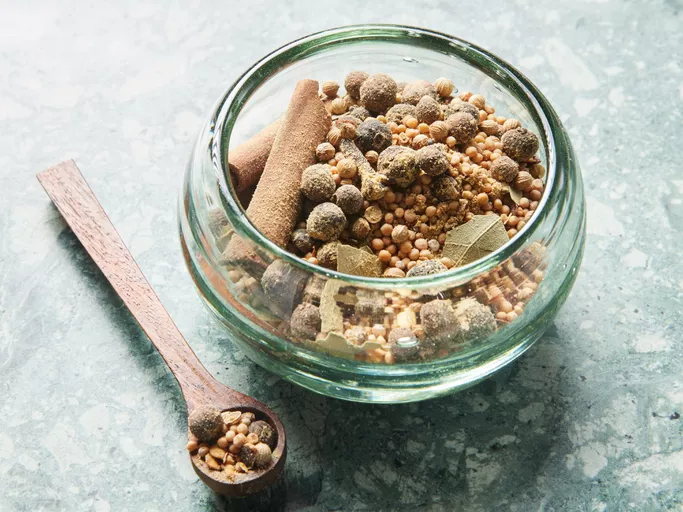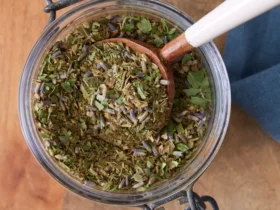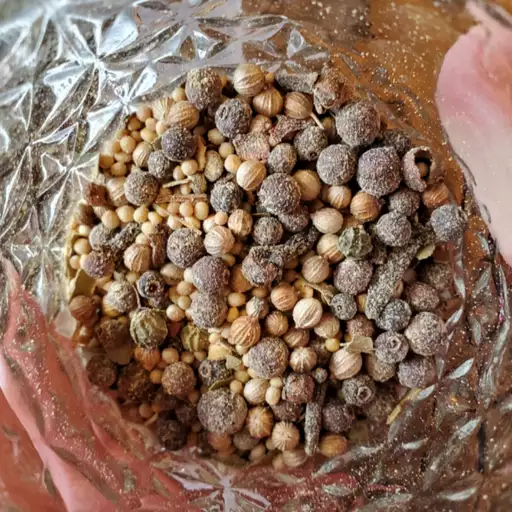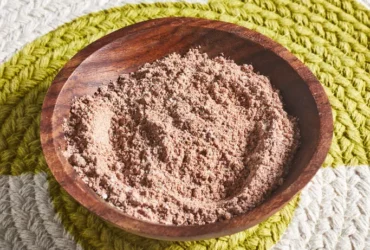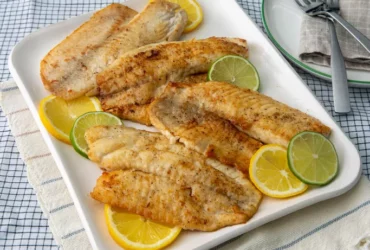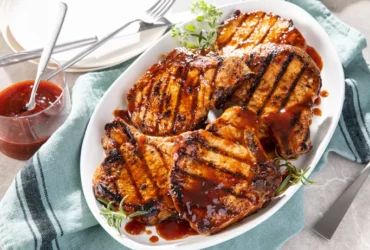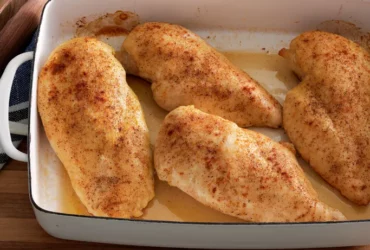Ingredients
Main Spice Components
The ingredients used to create homemade pickling spice can vary depending on personal preferences and the desired flavor profile. However, most traditional recipes include a combination of whole spices that are ground or bruised to release their flavors.
Common main spice components found in pickling spice blends typically include mustard seeds, coriander seeds, dill seeds, fennel seeds, and whole black peppercorns. These ingredients provide the foundation for the aromatic and flavor compounds that characterize pickled foods.
Mustard seeds add a pungent heat and earthy undertones to the blend. They can be yellow or brown in color and are often used in combination with coriander seeds to create a well-rounded flavor.
Coriander seeds have a citrusy, warm aroma and contribute a slightly sweet and nutty flavor to pickled dishes. Like mustard seeds, they come in two varieties: white (sweet) and brown (hot).
Dill seeds possess a fresh, herbaceous quality that is quintessential to many pickling spice blends. They are often used in combination with fennel seeds to create a delicate anise or licorice flavor.
Fennel seeds offer a mild anise or licorice taste and aroma, adding depth to pickled vegetables and meats.
Whole black peppercorns bring a sharp, pungent flavor and a distinctive crunch to the blend. They can be used whole or ground to release their flavors more efficiently.
In addition to these primary ingredients, some homemade pickling spice recipes may include other spices and seasonings such as cinnamon sticks, allspice berries, or cloves. These secondary components enhance the overall flavor profile of the blend and provide a unique twist on traditional pickling spices.
The art of pickling is a time-honored tradition that involves preserving vegetables or fruits in a solution of brine, sugar, and spices to create a tangy and flavorful condiment. To make a homemade pickling spice recipe, you’ll need a combination of aromatic ingredients that will add depth and complexity to your pickled creations.
The core components of any good pickling spice blend include:
Mustard seeds
These tiny seeds are the backbone of most pickling spice blends. They provide a tangy, slightly spicy flavor that’s essential for giving pickles their distinctive zing.
Coriander seeds
Similar to mustard seeds, coriander adds a warm, earthy flavor to your pickles. It’s also a key ingredient in many traditional spice blends.
Cinnamon sticks
A single cinnamon stick can add a sweet, comforting warmth to your pickling liquid. Be sure to use high-quality cinnamon for the best flavor.
Cardamom pods
These aromatic seeds are often used in Indian and Middle Eastern cuisine. They add a unique, slightly sweet flavor that complements the tanginess of mustard and coriander.
Cloves
Whole cloves have a strong, pungent flavor that pairs well with the sweetness of sugar and vinegar. Use them sparingly to avoid overpowering your pickles.
Allspice berries
These small, brown berries have a flavor profile that’s reminiscent of cinnamon, nutmeg, and ginger combined. They’re often used in traditional pickling spice blends.
Nutmeg
Like allspice, nutmeg has a warm, aromatic flavor that adds depth to your pickles. Be sure to use high-quality, freshly grated nutmeg for the best results.
To make a basic homemade pickling spice blend, combine the following ingredients in a small bowl:
- 2 tablespoons mustard seeds
- 1 tablespoon coriander seeds
- 1 cinnamon stick, broken into smaller pieces
- 4-6 cardamom pods, crushed slightly to release their flavor
- 6-8 whole cloves
- 2 allspice berries, crushed slightly to release their flavor
- 1/2 teaspoon freshly grated nutmeg
Mix the ingredients well and store them in an airtight container for up to 6 months. To use your homemade pickling spice blend, simply mix it with the sugar, vinegar, and salt called for in your recipe.
Cinnamon (1 tablespoon)
Cinnamon is one of the key ingredients that adds warmth and depth to homemade pickling spice. It is a common spice used in many sweet and savory dishes, but its presence in pickling spice is particularly noteworthy due to its ability to balance out the acidity and sweetness of the pickled vegetables.
The amount of cinnamon called for in this recipe is 1 tablespoon, which may seem like an unusual quantity given that cinnamon is typically associated with small quantities in most recipes. However, when combined with other spices in a large quantity, even small amounts of certain spices can have significant effects on the overall flavor profile.
Cinnamon works well as a pickling spice because it contains compounds such as cinnamaldehyde, which has antimicrobial properties that help to preserve the pickles. Additionally, cinnamon’s sweetness is complementary to the acidity in most vegetables and helps to balance out the flavors. It can be argued that the warmth of the cinnamon complements other spices like mustard seeds or coriander.
It is worth noting that different types of cinnamon have distinct flavor profiles and characteristics. Some of the more commonly used varieties include Ceylon, Cassia, and Saigon, with the latter being more pungent and sweet. For this recipe, it is recommended to use a high-quality Ceylon cinnamon or an equivalent variety.
When preparing homemade pickling spice, the cinnamon can be added in its ground form or as whole sticks, depending on personal preference. Ground cinnamon dissolves more quickly into liquid ingredients but may not have the same visual appeal as whole cinnamon sticks. In contrast, cinnamon sticks offer a nice aroma and can be removed before consuming the pickles.
Cloves (1/4 teaspoon)
Cloves are a key ingredient in many spice blends, including pickling spices, and serve several purposes in this recipe.
The primary function of cloves in pickling spice is to add warmth and depth to the blend, particularly when used in combination with other spices like cinnamon and allspice.
Cloves contain a chemical compound called eugenol, which has antiseptic properties that help preserve food by inhibiting the growth of bacteria and other microorganisms.
This is especially important for pickling vegetables, meats, or fish, as it helps to extend their shelf life and prevent spoilage.
In addition to its preservative properties, cloves also have a distinct, pungent flavor that complements the acidity in pickles and adds a rich, warm undertone to the blend.
When using cloves in this homemade pickling spice recipe, it’s essential to note that they should be used in moderation.
A small amount of 1/4 teaspoon is sufficient, as cloves can quickly overpower other flavors if used excessively.
The ideal ratio for cloves in a pickling spice blend is typically around 5-7% of the total weight of the spice mix, so adjust accordingly to achieve the perfect balance.
Nutmeg (1/8 teaspoon)
Nutmeg, often associated with sweet dishes such as pies and cakes, can also add a unique warmth to savory recipes like our homemade pickling spice blend.
The addition of 1/8 teaspoon of nutmeg brings a slightly aromatic and earthy flavor to the blend, which pairs well with the other spices and seasonings in this recipe.
Nutmeg’s warm, slightly sweet flavor is a key component of traditional pickling spice blends, particularly those used for corned meats like beef or pork.
In the context of our homemade pickling spice recipe, the nutmeg serves to enhance the overall depth and warmth of the blend, balancing out the brightness of the other spices like mustard seed and coriander.
The small amount of 1/8 teaspoon also helps prevent the nutmeg from overpowering the other flavors in the blend, making it an ideal addition for pickling applications where a subtle yet nuanced flavor is desired.
Black Pepper (1/2 teaspoon)
In this recipe for homemade pickling spice, we’ll be using black pepper as one of the key ingredients. Black pepper is a staple spice that adds depth and warmth to a variety of dishes, including our pickling spice blend.
Here are some interesting facts about black pepper:
- Black pepper is made from the dried berries of the Piper nigrum plant, which is native to India and Southeast Asia.
- The berries are harvested when they’re still green and unripe, and then they’re processed to remove the outer layer and reveal the inner seed.
- Black pepper contains a number of compounds that give it its distinctive flavor and aroma, including piperine, which has antioxidant properties.
In terms of its culinary uses, black pepper is one of the most versatile spices in the world. It’s commonly used to add heat and flavor to a variety of dishes, from savory meats and vegetables to soups and sauces.
For this recipe for homemade pickling spice, we’ll be using 1/2 teaspoon of black pepper. This amount will add a subtle warmth and depth to the blend without overpowering the other flavors.
Some tips for working with black pepper include:
- Use fresh black pepper whenever possible, as it has a more vibrant flavor than stale or old pepper.
- Store black pepper in an airtight container to preserve its flavor and aroma.
- Grind your own black pepper just before using it, as pre-ground pepper can lose its flavor and aroma over time.
The art of creating homemade pickling spice begins with selecting an array of ingredients that not only provide flavor but also aroma. The traditional pickling spices used are often a combination of whole spices and ground spices that complement each other in their taste, texture, and smell.
One key component is mustard seeds. These tiny, brown or white seeds possess a pungent, slightly bitter taste and are commonly utilized in various types of pickles and condiments to add depth and complexity.
Coriander seeds, another essential element, offer an earthy flavor when ground into powder form but retain their unique aroma as whole spices. Coriander is often associated with a warm, citrusy note.
Whole cloves are known for their distinctively pungent, warm flavor that adds depth and character to pickled vegetables. Cloves come in various shapes and sizes, with the whole seed being most commonly used due to its more pronounced taste than ground form.
Bay leaves bring a slightly bitter yet mellow flavor along with an aromatic quality when added to homemade pickling spice blends. The key is using fresh or dried bay leaves for optimal effect.
Cardamom pods are another significant ingredient, offering a distinctive sweet and spicy aroma that enhances the taste of various types of pickles and condiments. Green cardamom pods have a strong aromatic flavor whereas the white cardamom has a milder version.
A pinch of black pepper adds an unmistakable, sharp and pungent flavor to homemade pickling spice mixes. While often overlooked, this addition significantly complements other spices within the blend.
The sweetness associated with cinnamon powder is well-balanced by its spicy undertones making it a suitable choice for enhancing homemade pickling spice recipes without overpowering their overall taste or texture.
The selection of ingredients for homemade pickling spice ultimately comes down to personal preference, as individual tastes and regional traditions influence what combinations prove most effective in the end.
Additional Seasonings
The art of pickling is not only a way to preserve vegetables, but also to enhance their flavor and nutritional value. A key component of pickling is the blend of spices and seasonings used in the recipe. For those who enjoy experimenting with different flavors, creating your own homemade pickling spice recipe is a great way to add a personal touch.
Below are some common ingredients found in store-bought pickling spice blends:
- Cinnamon: adds warmth and depth
- Nutmeg: provides a slightly sweet and nutty flavor
- Ginger: brings a spicy kick
- Black pepper: enhances the overall flavor of the dish
- Bay leaves: contributes a mild, slightly bitter taste
- Allspice: adds a sweet, earthy flavor reminiscent of cloves
- Cloves: provides a strong, pungent aroma and flavor
- Red pepper flakes or cayenne pepper: add a spicy kick for those who enjoy heat
For a basic homemade pickling spice recipe, you can start with the following ingredients:
- 1 tablespoon whole black peppercorns
- 1 tablespoon coriander seeds
- 2 cloves whole allspice berries
- 4-6 whole cloves
- 4-6 whole bay leaves
- 2 teaspoons whole cinnamon sticks
To make your homemade pickling spice blend, start by grinding the spices into a fine powder using a spice grinder or mortar and pestle. You can also use pre-ground spices as a substitute.
Sift the ground spices through a fine-mesh sieve to remove any lumps or large particles. This will ensure that your pickling spice is evenly distributed in the pickles.
For added depth of flavor, you can include other ingredients such as dried mustard seeds, dill weed, and fennel seeds in your homemade pickling spice blend. Simply grind them into a fine powder using a spice grinder or mortar and pestle, and sift through a fine-mesh sieve before adding to the recipe.
Remember that you can adjust the proportions of each ingredient based on personal taste preferences. Feel free to experiment with different combinations of spices to create your perfect homemade pickling spice blend!
This homemade pickling spice blend is great for use in various recipes, including brined vegetables, fermented cucumbers, and even pickled fruits like carrots and beets.
To create an authentic homemade pickling spice recipe, you’ll need a combination of aromatic and flavorful ingredients that complement one another.
The core components of any pickling spice blend include Spices, which are dried seeds, bark, roots, or fruits that add flavor to dishes. In the context of this recipe, we will focus on using whole spices rather than ground ones for a more complex and balanced taste.
A good starting point is to include common pickling spices like Cumin Seeds, Coriander Seeds, and Fennel Seeds. These ingredients are essential in traditional pickling spice recipes as they add earthy, warm, and sweet flavors.
To complement the earthy undertones provided by cumin seeds and coriander seeds, you can add a small amount of Clove Powder for its distinct, slightly bitter taste that enhances depth without overpowering other ingredients.
Additionally, you can include a moderate amount of Ginger to infuse warmth and subtle spiciness into your pickling spice blend. Fresh ginger is preferred as it yields the most potent flavor.
The heat component in our homemade pickling spice recipe is primarily from Red Pepper Corns (also known as Red Chili Peppers). Use whole red pepper corns to avoid over-spicing and have control over the final heat intensity. Start with a small quantity if you prefer milder flavors.
Last but not least, include some aromatic leaves like Basil Leaves for its mild sweetness that balances out the overall spiciness of the recipe. Fresh or dried basil can be used, depending on your preference.
To bind all these spices together and make them easily blendable, use a small amount of Salt as an abrasive to facilitate grinding while keeping flavors intact.
Now that we have all our ingredients ready, the next step is to combine them in a specific ratio or proportion suitable for your pickling spice recipe.
Fennel seeds (1 tablespoon)
When it comes to adding a unique flavor dimension to our homemade pickling spice recipe, we turn to the versatile and aromatic fennel seeds.
Fennel seeds are the dried seeds of the fennel plant (Foeniculum vulgare), which is a flowering plant belonging to the carrot family (Apiaceae).
The seeds have a distinctive sweet anise-like flavor and aroma, with a hint of licorice, making them an excellent addition to our pickling spice blend.
To include fennel seeds in our recipe, we recommend using 1 tablespoon as the standard quantity.
Here’s what you can expect from incorporating fennel seeds into your homemade pickling spice mix:
- Flavor Profile: Sweet anise-like flavor with a hint of licorice, adding depth and complexity to the pickling process.
- Aroma: Distinctive sweet aroma that complements the other spices in the blend, enhancing the overall pickling experience.
- Energetic Properties: Fennel seeds have been traditionally used for their potential digestive benefits and as a breath freshener.
In terms of pairing fennel seeds with other spices, you can combine them with coriander seeds, cinnamon powder, ginger powder, or turmeric powder to create a balanced and aromatic pickling spice blend.
Remember to store your homemade pickling spice mixture in an airtight container to maintain its potency and shelf life, allowing you to enjoy the unique flavors of fennel seeds for months to come.
Bay leaves (2 whole leaves)
Bay leaves are a key ingredient in many pickling spice blends, and for good reason. They add a distinct flavor that is both warm and aromatic.
The bay leaf has been used for centuries to add depth and complexity to various dishes, including pickles and relishes. In fact, the bay leaf is one of the oldest spices known to humans, with evidence of its use dating back over 4,000 years.
When it comes to using bay leaves in your homemade pickling spice recipe, you’ll want to start by selecting high-quality whole leaves. Look for leaves that are fresh and fragrant, with no signs of wilting or browning. A good rule of thumb is to choose leaves that have a delicate, velvety texture.
For this particular recipe, you’ll need 2 whole bay leaves. You can use either sweet bay (Laurus nobilis) or California bay (Umbellularia californica), both of which will add a rich, slightly bitter flavor to your pickling spice blend.
Why Bay Leaves Are Important
- Adds depth and complexity to the pickling spice blend
- Has been used for centuries in various cuisines
- Pairs well with many other spices and seasonings, including garlic, mustard seeds, and coriander
In terms of how bay leaves will be used in your homemade pickling spice recipe, they’ll typically be combined with other ingredients like spices, herbs, and aromatics to create a unique blend. This blend can then be added to the brine or seasoning mixture for your pickles.
The art of pickling begins with selecting the right ingredients to create a homemade pickling spice blend that enhances the flavors of your vegetables, fruits, and other pickled delights. A well-balanced pickling spice recipe typically includes a combination of spices, herbs, and sometimes even sweet elements.
Spices are the foundation of any pickling spice blend, providing warmth, depth, and character to the mixture. The most commonly used spices in homemade pickling spice recipes include:
- Cinnamon
- Cardamom
- Nutmeg
- Allspice
- Ginger in the form of dried ginger or crystallized ginger
Herbs add freshness, aroma, and a touch of bitterness to balance out the sweetness of other ingredients. Some popular herbs used in homemade pickling spice recipes include:
- Dill weed
- Fenugreek leaves
- Garlic in powder or whole form
Sweet elements can be added to enhance the flavor and aroma of your pickling spice blend. These may include:
- Sugar or malt vinegar
- Brown sugar or molasses
Other ingredients that can be added to your pickling spice blend, depending on personal preference and the desired flavor profile, include:
- Cayenne pepper for a spicy kick
- Anise seeds
- Star anise
The key to creating a well-balanced homemade pickling spice blend is to experiment with different combinations of ingredients and ratios until you find the perfect balance for your taste buds.
Instructions for Blending Spice Mix
Grind Main Components
To blend a perfect pickling spice mix, you will need to grind the main components into fine powders or small particles. The primary goal is to achieve an even distribution of flavors and aromas throughout the mix. To start, gather your ingredients and equipment:
Main Components:
- Pickling spice seeds (e.g., coriander, caraway, or dill)
- Whole spices (e.g., mustard seeds, fennel seeds, or dill weed)
- Aromatic roots and stems (e.g., celery root, parsley root, or bay leaves)
Grinding Equipment:
- Spice grinder or coffee mill
- Mortar and pestle
- Food processor with a spice-grinding attachment
- Manual mortar and pestle (for small batches)
Instructions for Grinding the Main Components:
Begin by sorting and cleaning each type of ingredient. For example, remove any debris or broken seeds from the pickling spice seeds.
Grind the pickling spice seeds into a fine powder using a spice grinder or coffee mill. Be careful not to over-process, as this can lead to a bitter flavor.
Next, grind the whole spices (e.g., mustard seeds and fennel seeds) separately in the same manner as the pickling spice seeds.
For aromatic roots and stems like celery root or parsley root, peel and chop them into small pieces before grinding in a food processor with a fine-grating attachment.
If you’re using bay leaves or other large leaves, simply tear them into smaller pieces and grind them in the food processor as well.
Continue to blend the ground components together in a bowl until you achieve an even mix of flavors and aromas.
Taste and adjust the seasoning as necessary before using your homemade pickling spice mix for canning or preserving pickles, sauerkraut, and other fermented foods.
Remember to store your blended spice mix in airtight containers to maintain its freshness and flavor intensity. You can also add other ingredients, like grated ginger or onion powder, to customize the blend to your taste preferences.
The process of blending spice mix is a crucial step in creating a homemade pickling spice recipe. To ensure the perfect blend, it’s essential to combine the right proportion of spices and other ingredients.
First, preheat a small dry pan over medium heat. Then, add 1-2 tablespoons of whole spices such as cinnamon sticks, coriander seeds, and allspice berries. Roast the spices for about 5 minutes or until fragrant, stirring occasionally to prevent burning.
Remove the pan from the heat and let it cool slightly. Transfer the roasted spices to a spice grinder or a coffee grinder, depending on your preference. Grind the spices into a fine powder.
In a separate bowl, combine 2-3 tablespoons of ground spices such as cayenne pepper, ground ginger, and mustard seeds. Add 1 tablespoon of salt and 1/4 teaspoon of black pepper.
Mix the ground spice mixture with the roasted spice powder until well combined. Taste the blend and adjust the seasoning as needed.
Transfer the blended spice mix to an airtight container such as a glass jar or a plastic container. Store it in a cool, dark place for up to 6 months. This homemade pickling spice recipe can be used to make delicious pickles, relishes, and sauces.
Note: You can adjust the proportion of spices according to your personal taste preferences. Some people like their pickles more spicy, while others prefer them sweeter or milder. Experiment with different combinations to find the perfect blend for you.
Take the cinnamon sticks and grind them into fine powder using a coffee grinder or spice grinder.
To create your own blend of pickling spice, you’ll need to start by preparing the individual spices that will make up the blend.
Grinding the Cinnamon Sticks
Take the cinnamon sticks and grind them into a fine powder using either a coffee grinder or spice grinder. This step helps to release the oils and flavors of the cinnamon, allowing it to be evenly distributed throughout the pickling spice mixture.
Why Grind the Cinnamon Sticks?
The reason for grinding the cinnamon sticks is that they are typically sold whole in stores, which makes it difficult to achieve an even distribution of their flavor and oils in the pickling spice blend. By grinding them into a fine powder, you ensure that each component of the blend is properly infused with the warm, aromatic flavor of the cinnamon.
Other Spices for Grinding
Depending on your recipe, other spices that may require grinding include coriander seeds, mustard seeds, and dill seeds. Use a spice grinder or coffee grinder to grind these ingredients into fine powders as well, just like the cinnamon sticks.
Grainy Texture is Okay
You don’t have to achieve a completely smooth powder from your grinding process. A slightly grainy texture can actually add character and depth to the finished pickling spice blend.
Safety First!
When working with any type of grinder, be sure to follow basic safety precautions. Keep loose clothing and long hair tied back away from the grinder, and avoid wearing jewelry that could get caught in the blades. Also, make sure the area around you is clear of clutter and tripping hazards.
Storage Tips
Store your ground cinnamon powder in airtight containers to keep it fresh for as long as possible. You can also store other ground spices in separate containers or combine them in one container, depending on how much space you have available and how you plan to use the pickling spice blend.
Measuring Spices
To create your own homemade pickling spice blend using ground cinnamon powder, coriander, mustard seeds, dill seeds, and other spices, follow this rough guide:
- Cinnamon: 1/2 cup
- Coriander: 1/4 cup
- Mustard Seeds: 1 tablespoon
- Dill Seeds: 1 tablespoon
- Garlic Powder: 1 teaspoon
- Ground Turmeric: 1/2 teaspoon
- Salt: To taste
You can adjust the proportions to suit your personal preferences.
To blend the homemade pickling spice mix, you’ll need to combine a variety of spices in the right proportions to create a balanced and flavorful blend. Here’s a step-by-step guide on how to blend your pickling spice mix:
Gather all the ingredients: You’ll need whole spices such as mustard seeds, coriander seeds, dill seeds, fennel seeds, brown mustard seeds, cumin seeds, and black peppercorns, as well as ground spices like turmeric powder, paprika powder, and salt.
Measure out the ingredients: Use a digital kitchen scale or measuring cups to accurately measure out each ingredient in the required quantities. A general ratio for this blend is:
- 20% Mustard seeds (whole)
- 15% Coriander seeds
- 10% Dill seeds
- 5% Fennel seeds
- 5% Brown mustard seeds
- 5% Cumin seeds
- 2.5% Black peppercorns (whole)
- 2.5% Turmeric powder
- 1.25% Paprika powder
- 1.25% Salt
Grind the whole spices: Use a spice grinder or mortar and pestle to grind each type of whole spice into a fine powder.
Combine the ground spices: Mix together the ground turmeric, paprika, salt, and any other ground spices in a small bowl.
Add the ground spices to the whole spices: Add the combined ground spices to the bowl containing the ground whole spices and mix well to ensure everything is fully incorporated.
Sift the spice blend: Use a fine-mesh strainer or sifter to sift the blended spice mixture into an airtight container. This will help remove any lumps and ensure the spice blend is evenly textured.
Store the spice blend: Store the homemade pickling spice mix in an airtight container in a cool, dark place for up to 6 months. Be sure to label the container with the date you made it and what’s inside, so you can easily identify your creation whenever you need it.
With these instructions, you’re now ready to blend your homemade pickling spice mix! This recipe will give you a deliciously balanced flavor that will elevate any pickling project. Enjoy experimenting with different spices and ratios to create unique blends that suit your taste preferences!
Mix All Ingredients Together
To blend a spice mix for homemade pickling, follow these steps:
Determine the ingredients needed for your spice mix. This may include common spices like garlic powder, onion powder, dried oregano, ground mustard, coriander seeds, and paprika. You can also add or substitute other ingredients to suit your taste preferences.
Pick a container that is dry and free from any lingering flavors. A small bowl or measuring cup works well for this task.
Measure out each of the required ingredients using a digital kitchen scale or measuring cups. Record the measurements for future reference, as you can adjust the proportions to suit your taste preferences.
Add the measured ingredients to the container. You can add them in any order, but it may be helpful to group similar ingredients together (e.g., spices that have a strong flavor like garlic powder and onion powder, or those with a slightly bitter taste like paprika and coriander seeds).
Blend the ingredients together using a spoon, whisk, or even a small electric mixer. The goal is to break down any clumps and distribute the flavors evenly throughout the mix.
Check the consistency of your spice mix after blending. If it seems too chunky or uneven, blend for another minute or until the desired texture is achieved.
Transfer the blended spice mix to an airtight container, such as a glass jar with a tight-fitting lid. This will help maintain the freshness and aroma of your homemade pickling spice.
Store the container in a cool, dark place, away from direct sunlight or heat sources. With proper storage, your homemade pickling spice can last for up to 6 months or more.
To blend the spice mix for your homemade pickling spice recipe, you will need a clean and dry work surface as well as a small bowl to hold the spices.
First, sift or measure out each spice according to the proportions listed in the recipe. This may include ingredients such as whole black peppercorns, coriander seeds, dill weed, mustard seeds, and red pepper flakes, among others.
Place the measured spices into a small bowl and use your hands or a small spoon to mix them together until they are evenly combined.
If you want to create a more uniform blend, you can use an electric spice grinder or coffee grinder to grind the whole spices into smaller pieces. Simply add 1-2 tablespoons of the whole spices at a time to the grinder and process until they reach the desired consistency.
Once your spices are ground, sift them through a fine-mesh sieve or cheesecloth into the bowl with the other ingredients. This will help to remove any lumps or large particles and ensure that the spice mix is evenly textured.
Repeat this process until all of the whole spices have been ground and sifted into the bowl, then use your hands or a small spoon to mix everything together one final time.
To finish the blend, transfer it to an airtight container and store it in a cool, dry place. The spice mix can be used immediately or stored for up to 6 months.
In a small bowl, combine the ground cinnamon, cloves, nutmeg, black pepper, fennel seeds, and bay leaves. Mix until well combined.
To blend the spice mix for this homemade pickling spice recipe, you will need to combine several aromatic spices and herbs in a small bowl.
First, start by gathering the following ingredients: ground cinnamon, cloves, nutmeg, black pepper, fennel seeds, and bay leaves.
Once you have all of your ingredients in front of you, it’s time to begin combining them. In the small bowl, start by adding a generous amount of ground cinnamon. You can use a measuring spoon to ensure you are using the right amount.
Next, add a few whole cloves to the bowl. Be sure to break up any large cloves into smaller pieces so they mix evenly with the other ingredients.
Now, add a pinch of nutmeg to the bowl. Nutmeg has a strong flavor, so be careful not to add too much. A little goes a long way in this recipe.
Add a few whole black pepper corns to the bowl. Black pepper adds depth and warmth to the spice mix, so don’t be shy about using it.
Mix in some fennel seeds. Fennel adds a sweet anise flavor that pairs perfectly with pickles.
Finally, add a few bay leaves to the bowl. Bay leaves have a mild flavor and a pleasant aroma that complements the other spices nicely.
Once all of your ingredients are in the bowl, use a spoon or whisk to mix them until they are well combined. You can also use a small pastry blender or food processor to help break up any large pieces of spice and blend everything together evenly.
After mixing, store the homemade pickling spice mixture in an airtight container at room temperature for up to 6 months. Use it to season your favorite pickled vegetables and enjoy the flavor of freshly blended spices!
To blend the homemade pickling spice recipe, start by gathering all the ingredients in a large bowl or container.
Mix together 2 tablespoons of brown mustard seeds, 1 tablespoon of whole coriander seeds, and 1 tablespoon of whole dill weed seeds until they are evenly distributed.
Add 1 teaspoon of ground turmeric powder and 1/2 teaspoon of ground cayenne pepper to the bowl and mix well with the mustard seeds mixture.
Next, add in 1/4 cup of freshly ground black peppercorns and mix until the spices are evenly coated.
Now it’s time to add in the salt: mix together 2 tablespoons of kosher salt and 1 tablespoon of pink curing salt (if using) with the other spice ingredients.
Continue mixing all the ingredients together until you have a well-balanced and evenly distributed blend of spices.
To check if your mixture is blended correctly, try to separate the different components. If they can be easily separated by eye or taste, continue blending for a bit longer until the desired consistency is achieved.
Transfer the homemade pickling spice blend to an airtight container and store it in a cool, dark place for up to 6 months.
Before using your homemade pickling spice blend, give it a good stir to make sure all the ingredients are well combined. You can also use this blend as a dry rub for meats or add it to soups and stews for extra flavor.
Using Your Homemade Pickling Spice Blend
Tips for Using the Spice Blend
Using Your Homemade Pickling Spice Blend
With your homemade pickling spice blend at hand, the possibilities are endless! This versatile spice mix can be used to add flavor to a variety of dishes, from tangy pickles and sauerkraut to savory meats and stews.
Tips for Using the Spice Blend
Pickling
Use your homemade pickling spice blend to make traditional dill pickles, sweet pickles, or even Korean-style kimchi. Simply combine the spice blend with vinegar, water, salt, and your choice of vegetables or cucumbers, and let it sit for a few days to allow the flavors to meld.
Sauerkraut
Add your homemade pickling spice blend to sauerkraut recipes for an authentic German flavor. Combine the spice blend with shredded cabbage, caraway seeds, and salt, and let it ferment for several weeks.
Meats
Rub your homemade pickling spice blend onto meats such as pork, beef, or lamb before grilling or roasting for a smoky, savory flavor.
Stews and Soups
Add your homemade pickling spice blend to stews and soups for an extra boost of flavor. It pairs particularly well with hearty beef or vegetable stews.
Marinades
Use your homemade pickling spice blend as a marinade for grilled meats or vegetables. Combine the spice blend with olive oil, vinegar, and other desired ingredients to create a flavorful sauce.
Cheese
Add your homemade pickling spice blend to cheese recipes for an authentic German flavor. It pairs particularly well with Sauerkraut-style cheeses like tangy Gouda or sharp Cheddar.
Remember, the beauty of making your own pickling spice blend is that you can customize it to suit your taste preferences and dietary needs. Feel free to experiment with different ingredients and ratios until you find the perfect blend for you!
The art of pickling has been around for centuries, with different cultures and regions developing their own unique spice blends to enhance the flavor of vegetables and fruits. One of the most versatile and delicious homemade pickling spice blends is a combination of aromatic spices that can be easily made at home using common ingredients.
This blend typically includes a mixture of warm spices like cinnamon, nutmeg, and cardamom, along with more pungent flavors from cloves, allspice, and ginger. Some recipes may also include additional ingredients such as mustard seeds, coriander seeds, or dill seeds to add depth and complexity to the blend.
To make a basic homemade pickling spice blend, you will need the following ingredients: 2 tablespoons of whole cinnamon sticks, 1 tablespoon of whole nutmeg, 1 teaspoon of ground cardamom, 1/2 teaspoon of ground cloves, 1/4 teaspoon of ground allspice, and 1/4 teaspoon of grated fresh ginger. You can adjust the quantities to suit your personal taste preferences.
Begin by grinding each spice in a spice grinder or mortar and pestle until it reaches the desired consistency. For example, you may choose to leave some spices whole for added texture, while others are ground into fine powders for easier mixing.
Mix all the spices together in a small bowl until they are evenly combined. You can store your homemade pickling spice blend in an airtight container at room temperature for up to 6 months. Before using, simply add a pinch of the spice blend to your pickled vegetables or fruits and enjoy the flavor!
One of the benefits of making your own pickling spice blend is that you can customize it to suit your taste preferences and dietary needs. For example, if you’re looking for a spicier blend, simply add more ground ginger or cloves. If you prefer a sweeter blend, use more cinnamon or nutmeg.
Another advantage of homemade pickling spice blends is their cost-effectiveness. By purchasing whole spices in bulk and grinding them yourself, you can significantly reduce your costs compared to buying pre-mixed commercial blends that may contain additives or preservatives.
Additionally, making your own pickling spice blend allows for greater flexibility when it comes to the ingredients and proportions used. You can adjust the quantities of each spice based on your personal preferences, ensuring that you get a flavor profile that suits your taste buds perfectly.
The final result is a delicious homemade pickling spice blend that can be used in countless ways. Simply sprinkle a pinch over sliced cucumbers or carrots for a quick and easy snack, or add it to your favorite salad dressings or marinades for added depth of flavor. With this simple recipe, you’ll never run out of creative ideas to use up your homemade pickling spice blend!
This blend can be used to make pickled vegetables, fruits, and eggs. For best results, use it immediately or store in an airtight container.
The joy of having a homemade pickling spice blend at your disposal! With this versatile mixture, you can add flavor and zest to an array of pickled delights, including vegetables, fruits, and eggs.
Using Your Blend
Simply sprinkle the homemade pickling spice blend over your chosen ingredients before submerging them in a brine or vinegar solution. The possibilities are endless – try pickling sliced cucumbers for traditional dill pickles, bell peppers for sweet and crunchy snacks, or even eggs for a tasty breakfast side.
Storage Tips
For best results, use the homemade pickling spice blend immediately after preparation. However, if you don’t plan to use it right away, store it in an airtight container to maintain its potency and freshness. This will ensure that your pickles retain their signature flavor and aroma.
Remember, with a homemade pickling spice blend on hand, the world of pickled delights is at your fingertips. Experiment with different ingredients, flavors, and combinations to create truly unique and mouth-watering creations!
Once you have created your homemade pickling spice blend, it’s time to start using it to add flavor and zing to a variety of dishes.
One of the most obvious uses for pickling spice is in traditional pickling recipes.
To make delicious homemade pickles, combine sliced cucumbers with a brine made from vinegar, salt, and your homemade pickling spice blend.
Let the mixture sit at room temperature for a few hours or overnight to allow the flavors to meld together.
Then, refrigerate the pickles and enjoy them as a snack or side dish.
You can also use your homemade pickling spice blend in other recipes, such as braising greens like kale or collard greens, adding flavor and depth to soups and stews, and even using it as a rub for meats before grilling or roasting.
The possibilities are endless, so don’t be afraid to experiment and come up with your own unique uses for your homemade pickling spice blend.
To enhance the flavor of your pickles, you can also add other ingredients such as sliced onions, garlic, or dill.
These additional flavors will complement the taste of the pickling spice and create a delicious and tangy snack.
In addition to using your homemade pickling spice blend in traditional pickling recipes, you can also use it as a topping for sandwiches or salads.
The combination of spices in the pickling spice blend will add a burst of flavor and freshness to any dish.
Overall, making your own homemade pickling spice blend is a great way to add depth and complexity to a variety of dishes, and it’s a fun and easy process to try at home.
- Best Lusha Alternatives for 2025 - April 22, 2025
- Best Overloop Alternatives for 2025 - April 22, 2025
- Best 6sense Alternatives for 2025 - April 22, 2025

